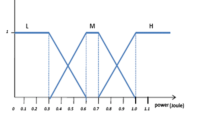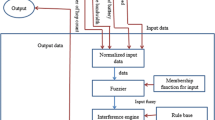Abstract
The dynamic nature of Mobile Ad hoc Networks (MANETs) demands a new-fangled set of communication strategies to enhance the performance of Quality of Service (QoS). It is very difficult to find viable QoS routes in MANETs due to its environment. AODV version 2 is called Dynamic MANET On-demand (DYMO) Routing protocol. Drawback of AODV is, it does not support larger networks. DYMO supports both medium and larger networks. To enhance the performance of DYMO, this paper proposes FBNTT DYMO by applying dynamic Node Traversal Time (NTT) in place of defacto NTT using fuzzy logic and Matlab. Fuzzy concept is used by taking network size and mobility is inputs and NTT as output. NTT plays a vital role in improving QoS in MANETs. For the Existing DYMO the default NTT value is 90 ms in QualNet simulator, however in a lively and dynamic environment we should not depend on the static values during protocol configuration. This paper implements FBNTT DYMO using QualNet simulator. The QoS metrics used are: throughput, delay, jitter and First packet received. The experimental result reveals that FBNTT DYMO radically improves the QoS as compared with defacto NTT–DYMO.











Similar content being viewed by others
References
Hanzo, L., & Tafazolli, R. (2007). A survey of QoS routing solutions for mobile ad hoc networks. IEEE Communications Surveys, 9(2), 50–70.
Venkataramana, A., & Setty, S. P. (2013). Impact of NTT on the performance of DYMO routing protocol in MANETs. IJWCNT, 3(2), 35–39.
Venkataramana, A., & Pallam Setty, S. (2015). Cross layer design approach to enhance the quality of service in mobile ad hoc networks, wireless personal communications, Vol. 82. New York: Springer. doi:10.1007/s11277-015-2609-6
Venkataramana, A., & Pallam Setty, S. (2013). Impact of MAC layer on AODV and LAR routing protocols in MANETs. International Journal of Computer Applications (0975–8887), 84(4), 30–34.
Venkataramana, A., & Pallam Setty, S. (2013). Performance evaluation of DSR and LAR routing protocols with MAC layer in MANET’s. IJCSMC, 2(11), 277–284.
Conti, M., Maselli, G., Turi, G., & Giordano, S. (2004). Cross-layering in mobile ad hoc network design. IEEE(Xplore) Computer Society, 37(2), 48–51. doi:10.1109/MC.2004.1266295
Maan, F., & Mazhar, N. (2011). MANET routing protocols vs mobility models: A performance evaluation. Ubiquitous and Future Networks (ICUFN), pp. 179–184. Print ISBN: 978-1-4577-1176-3.
Devi, M., & Rhymend Uthariaraj, V. (2012). Fuzzy based route recovery technique for mobile ad hoc networks. European Journal of Scientific Research, 83(1), 129–143. ISSN 1450-216X, Euro Journals Publishing.
Raju, K. N., & Setty, S. P. (2012). Design and analysis of fuzzy based node traversal time AODV for improving the QoS in mobile ad hoc networks. International Journal of Computer Applications (0975–8887), 58(9), 39–42.
Ibrahim, M., Mehmood, T., & Ullah, F. (2011). QoS providence and management in mobile ad hoc networks, international conference on computer engineering and applications IPCSIT (Vol. 2). Singapore: IACSIT Press.
Ayyasamy, A., & Venkatachalapathy, K. (2014). Context aware adaptive fuzzy based QoS routing scheme for streaming services over MANETs. Wireless Networks, 21, 421–430. doi:10.1007/s11276-014-0801-3. Published online: Springer Science Business Media New York.
Chakrabarti, S., & Mishra, A. (2004). Quality of service challenges for wireless mobile ad hoc networks. Wiley Journal of Wireless Communications and Mobile Computing, 4, 129–153.
Arora, D., Millman, E., & Neville, S. (2011). Assessing the performance of AODV, DYMO, and OLSR routing protocols in the context of largerscale denser MANETs. The hand book of ad hoc networks. Boca Raton: CRC Press. 978-1-4577-0253-2/11, IEEE.
Chaba, Y., & Patel, R. B. (2012). Issues and challenges involved in multipath routing with dymo protocol. International Journal of Information Technology and Knowledge Management, 5(1), 21–25.
Gupta, A. K. (2013). Implementation of DYMO routing protocol. International Journal of Information Technology, Modeling and Computing. 1(2), 49–57.
Draft-IETF-MANET-DYMO; Internet draft-2013.
QualNet Network Simulator. http://www.scalable-networks.com
Author information
Authors and Affiliations
Corresponding author
Rights and permissions
About this article
Cite this article
Venkataramana, A., Setty, S.P. Enhance the Quality of Service in Mobile Ad Hoc Networks by Using Fuzzy Based NTT–DYMO. Wireless Pers Commun 95, 2989–3002 (2017). https://doi.org/10.1007/s11277-017-3980-2
Published:
Issue Date:
DOI: https://doi.org/10.1007/s11277-017-3980-2




